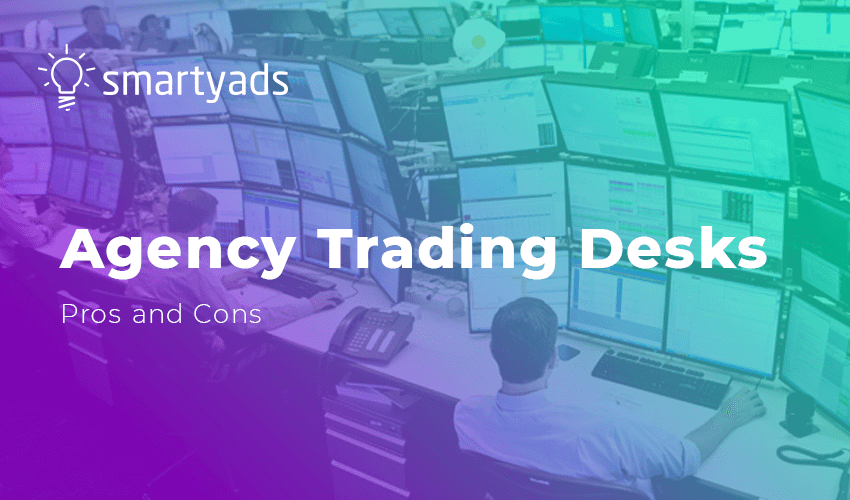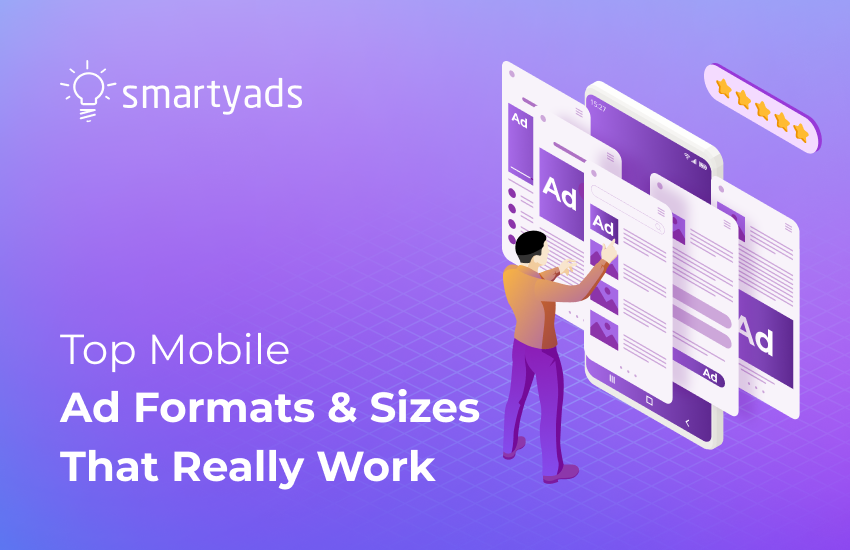If you're a media buyer, you've likely wondered whether to work with an agency trading desk (ATD) or manage your ad campaigns independently. With programmatic ad spending projected to reach $779 billion by 2028, it's an important decision for maximizing ROI. ATDs can streamline the process by accessing premium ad inventory and leveraging advanced targeting tools. In contrast, independent management may offer more control but can be resource-intensive. We're here to help you weigh the pros and cons and choose the best path for your advertising goals.

What is an agency trading desk?
An agency trade desk (ATD) is a centralized management platform that specializes in programmatic media buying (Things you need to know about programmatic buying), optimization of the digital advertising trading strategy, and marketing budgets. ATDs use either proprietary technology or a combination of a licensed demand-side platform (DSP) (much more information about what is DSP you can find here), ad server, data management platform (DMP), and other audience-buying tools to provide a sufficient technical ecosystem to help clients improve campaign performance and increase obtained value from their digital ad spend.
ADTs could be:
- A part of a large media agency, such as Accuen for Omnicom, Affiperf for Havas Group or Xaxis for WPP;
- Independent service-based organizations, such as Digilant, Run or Cadreon; or
- Separate ad tech units that purchase digital media on the behalf of their clients, usually advertisers and brands.
How Does an Agency Trading Desk Work?
Agency trading desks (ATDs) harness the power of high-tech wizardry and data wizardry to make the ad-buying process not just smoother but smarter, ensuring every penny of their client's investment works harder. Acting as the savvy middlemen in the bustling marketplace of digital ad trading, they're the maestros orchestrating a symphony of clicks and conversions. Let's dive deeper into the magic behind ATDs:
Real-Time Bidding (RTB) and Programmatic Buying: ATDs use real-time bidding to purchase ad inventory and optimize placements for the right audience at competitive prices.
Inventory Access and Partnerships: ATDs establish partnerships with publishers, SSPs, and ad exchanges to acquire high-quality ad inventory, which they resell to clients, providing access to premium ad placements without direct negotiations.
Audience Targeting and Analytics: ATDs use advanced analytics to refine targeting and tailor ad campaigns to specific audience segments, improving trading desk marketing efficiency.
Campaign Optimization: ATDs continuously monitor and adjust campaigns in real-time based on performance data to optimize key metrics and dynamically allocate the marketing budget.
Advisory and Strategy: ATDs advise clients on advertising strategies to achieve business goals efficiently, both locally and globally.
Reporting and Insights: ATDs track campaign performance and provide insights to help advertisers make informed decisions for future marketing strategies.
Flexible Pricing Models: ATDs offer various pricing models tailored to the advertiser’s goals, including CPM, CPC, CPI, and CPA, as well as more specific models like CPO, CPL, or CPS.
By combining real-time data analysis, inventory access, strategic guidance, and a focus on optimization, ATDs ensure that clients’ digital ad campaigns are both effective and cost-efficient.
What does it cost to use an agency trading desk?
Utilizing the services of an agency trading desk involves incurring a range of fees, which cover professional services such as targeting and audience analysis, costs for data aggregation and examination, as well as technical charges related to the use of platforms and infrastructure. Furthermore, there are additional agency fees, often calculated as a proportion of the media expenditure. An IAB report highlights that platforms enabling programmatic sales for media entities customarily retain between 10 to 20 percent of the generated revenues. The financial commitments associated with employing an agency trading desk's services can significantly fluctuate and, as such, warrant thorough negotiation beforehand to prevent the emergence of unforeseen charges.

Agency Trading Desk (ATD) vs. Demand-Side Platform (DSP)
ATDs may sound pretty similar to DSPs, and plenty of people still confuse these two terms. Agency trading desks are companies or organizations that employ digital media strategists, software engineers, account managers, data analysts, and other human resources to provide digital media buying services. ATDs use one or more DSPs to buy advertising space.
DSP stands for a digital platform created by advertising technology firms for those purchasing media. Utilizing the DSP platform, advertisers are able to strategize their ad campaigns, fine-tune their targeting preferences, and acquire ad spaces via methods such as real-time bidding auctions, private marketplaces, as well as through programmatic direct and automated guaranteed processes. DSPs are integral components of the programmatic trading desk environment, connecting to a vast collection of ad impressions via an ad exchange and purchasing from SSPs (Supply-Side Platforms) or ad networks.
Using DSPs, advertisers get direct access to the available media inventory, whereas when working with ATDs, media buyers pay extra fees to delegate this task to the agency and never execute buying themselves.
What are the benefits of working with ATDs?
Agency trading desks (ATDs) love to position themselves as the pros of the programmatic world, and for good reason. They hire top-tier talent, run campaigns for the big-name brands, and know how to play the field across different market segments. But what’s in it for advertisers? Here’s why working with an ATD might feel like striking gold:
Expertise on Tap: ATDs bring in experienced professionals who manage multiple high-stakes campaigns and bring industry know-how to your campaign.
Data Mastery: ATDs have their own data management platforms and ad servers, allowing for in-depth audience data analysis and smarter decision-making for marketers.
Historical Bidding Data: ATDs use historical data and algorithms to optimize bidding strategies for better performance and cost-efficiency, especially for repeat campaigns.
All-in-One Campaign Management: ATDs handle every detail of your digital ad campaign so you can focus on your core business.
Seamless Access to Programmatic Media: ATDs connect advertisers with demand-side platforms, managing real-time bidding to place ads effectively.
However, not everything that glitters is gold. While ATDs promise a lot, there’s always a trade-off. Watch out for hidden fees or opaque pricing models—sometimes that "managed service" comes with a hefty markup. It’s important to balance the perks with potential downsides before diving in.
Why Are Brands Abandoning ATDs
Working with agency trading desks (ATDs) may seem like a smart move at first, but trouble started brewing back in 2012. Since then, a growing number of top brands have ditched ATDs and brought media buying in-house to save money, boost transparency, and regain control of their budgets. Here’s why:
Double Fees: Some ATDs were tech innovators, but many just outsourced most of the technology and paid for third-party DSPs. This caused ad spend to skyrocket.
Conflict of Interest: ATDs act as both buyers and sellers of media inventory, which raises concerns about potential conflicts of interest.
Lack of Transparency: In 2014, 42% of marketers lost trust in ATDs due to concerns about media buying, performance metrics, ad viewability, and billing practices.
High Middleman Costs: Advertisers discovered that up to 80% of their budget was spent on middleman fees rather than actual media buying.
Fading Relevance: Digiday UK warned that "trading desks must evolve or face extinction" due to issues with transparency, efficiency, and results.
So, while ATDs offer convenience and expertise, the steep fees, conflicts of interest, and opaque practices leave many advertisers feeling like they’re getting a raw deal. It’s no wonder many brands are choosing to handle media buying themselves.
What to choose trading desk ads or direct buys in 2024
In 2024, marketers have more options than ever when deciding between agency trading desks and direct media buys. If working with an ATD feels murky—think hidden fees or lack of control—there’s always a DIY approach. Today’s media buyers can license trading desk programmatic technology directly, cutting out the middleman entirely. This means no more worrying about hidden margins or conflicting interests. By going direct, advertisers can take full control of their campaigns, gaining transparency over bidding, performance metrics, and budget allocation.
The decision comes down to priorities: if you want convenience and are comfortable outsourcing the details, an ad trading desk can still deliver value. But for those who want maximum transparency and tighter control over media spend, direct buying through programmatic platforms offers a streamlined, no-surprises approach.
To sum it up
While ATDs offer expertise and convenience, they often come with hidden costs and a lack of transparency. For marketers seeking control, efficiency, and clarity, the direct approach—using a demand-side platform (DSP) like SmartyAds—can provide the best of both worlds.
Take control of your advertising today. Discover the benefits of SmartyAds DSP and optimize your ad campaigns with complete transparency and efficiency.


.webp)


